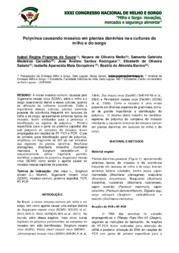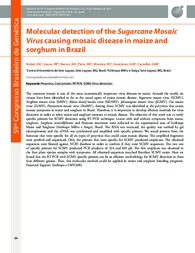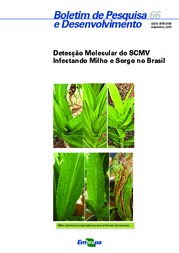Another sorghum mosaic virus is identified in Brazil
Another sorghum mosaic virus is identified in Brazil
For the first time in Brazil, researchers from Embrapa Maize and Sorghum identified the occurrence of the species Johnsongrass mosaic virus (JGMV) naturally infecting sorghum [Sorghum bicolor (L.) Moench] crops. Their studies also found a sorghum lineage that is resistant to the common mosaic caused by potyvirus species among the different genotypes they tested. In environmental conditions that favor the appearance of the disease, it can cause considerable losses to production, according to the researchers.
JGMV is the second virus identified in Brazil that caused such disorder in sorghum. “Previously, only the Sugarcane Mosaic Virus (SCMV) had been found causing mosaic to the species in the country”, informs the Embrapa researcher Isabel Regina Prazeres de Souza.
The results, published in the International Journal of Current Research, were obtained from molecular analyses of sample leaf tissue collected from the plants that presented mosaic symptoms. The samples were collected throughout the main producing regions of Minas Gerais state during the harvests of 2014/2015 and 2015/2016.
“For the first time, we have identified the occurrence of the JGMV virus in the fields infecting grain sorghum and silage sorghum in Brazil”, Isabel Souza underscores. Infected samples were collected in the Minas Gerais cities of Paracatu, Northwest of the state, and Felixlândia, located in Central Minas Gerais (figure 1).
Figure 1. Sorghum leaf expressing mosaic symptom due to JGMV infection
Sorghum is the fifth most cultivated cereal in the world
Sorghum is a cereal that is cultivated in several tropical and subtropical regions of the world. It is considered the top fifth cereal of the planet in production and in cultivated area, after wheat, rice, maize and barley. According to the Embrapa researcher José Avelino Santos Rodrigues, when compared with other cereals, this crop draws farmers' attention as it has superior adaptive characteristics for cultivation in areas under water stress. “This justifies cultivating sorghum in millions of hectares of Africa, Asia, Oceania and the Americas”, he explains.
Among the viroses that affect sorghum, a prominent one is common mosaic, which is caused by the potyvirus and causes reduced grain and forage production. Infected plant symptoms can be expressed as typical mosaic or as leaf necrosis, depending on the cultivar attacked. In the first case, the leaves show chlorotic areas between green areas (figure 2); in the second case, red or yellowish necrosed areas (figure 3).
| Figure 2. Sorghum plant expressing typical mosaic symptom in the leaves | Figure 3. Sorghum plant expressing necrotic symptom in the leaves |
Six species of mosaic-causing viruses
In the whole world, six species of potyvirus have been reported to cause common mosaic in maize or sorghum: Sugarcane mosaic virus (SCMV), Sorghum mosaic virus (SrMV), Maize dwarf mosaic virus (MDMV), Johnsongrass mosaic virus (JGMV), Zea mosaic virus (ZeMV) and Pennisetum mosaic virus (PenMV).
“In Brazil, sorghum common mosaic's causal agent was the SCMV species, which was previously identified in 2012 and whose strain to date has been found to be different from the ones reported for this species in other parts of the world. However, from now on, in the country there will be two potyvirus species capable of infecting and causing common mosaic in sorghum: SCMV and JGMV”, stresses the researcher Isabel Souza.
Transmission by aphids
In sorghum, the virus is transmitted by the corn aphid (Rhopalosiphum maidis) as well as by the greenbug (Schizaphis graminum), considered a key pest for this crop. Corn aphid is the most efficient vector in the transmission, and, in Brazil, it is found mainly in regions where sorghum and maize are cultivated as mid-season harvests.
According to researchers, the succession of grasses, maize and sorghum and the increase in vectors during the second harvest are factors that contribute to the growth of the incidence of common mosaic in both crops. Moreover, there is evidence of the presence of other potyvirus species whose identification is still necessary.
JGMV-resistant sorghum lineage
Out of the sorghum genotypes evaluated with regard to resistance to the JGMV infecting sorghum in Brazil, only one lineage, QL3, presented resistance to the virus. In addition, the species Euchlaena mexicana (teosinte) and Sorghum verticilliflorum (native sorghum) were infected and presented mosaic symptoms, the latter of which is considered a weed in different crop lands around the world.
The maize, sugarcane and Brachiaria genotypes evaluated by the research were not infected. “This demonstrates the need to make a broader assessment using a higher number of genotypes of such species”, ponders Isabel Souza.
“The QL3 lineare of sorghum represents an important source of resistance to JGMV to be used in breeding programs, aiming at the development of cultivars that are resistant to the mosaic caused by such species”, the scientist states.
The research was conducted with financial support from the Minas Gerais Research Support Foundation (Fapemig) and from Embrapa.
Translation: Mariana Medeiros
Sandra Brito (MTb 06.230/MG)
Embrapa Maize and Sorghum
Press inquiries
milho-e-sorgo.imprensa@embrapa.br
Phone number: +55 31 3027-1223
Further information on the topic
Citizen Attention Service (SAC)
www.embrapa.br/contact-us/sac/




